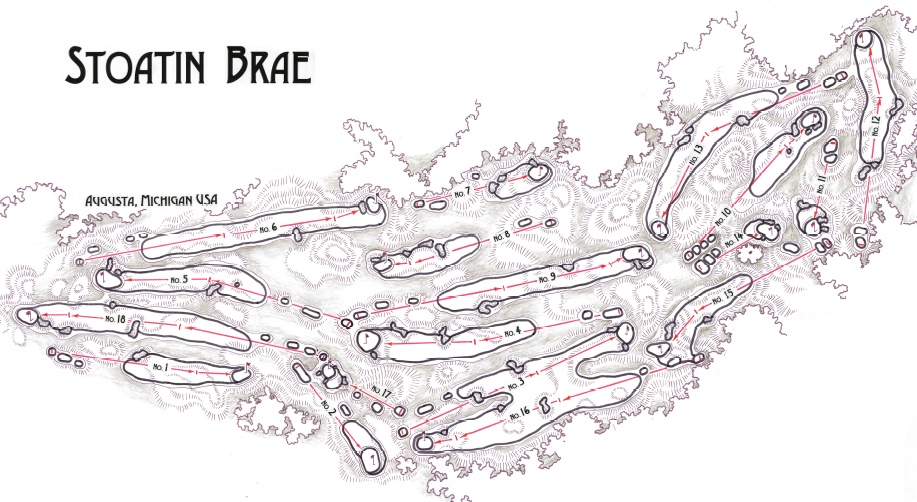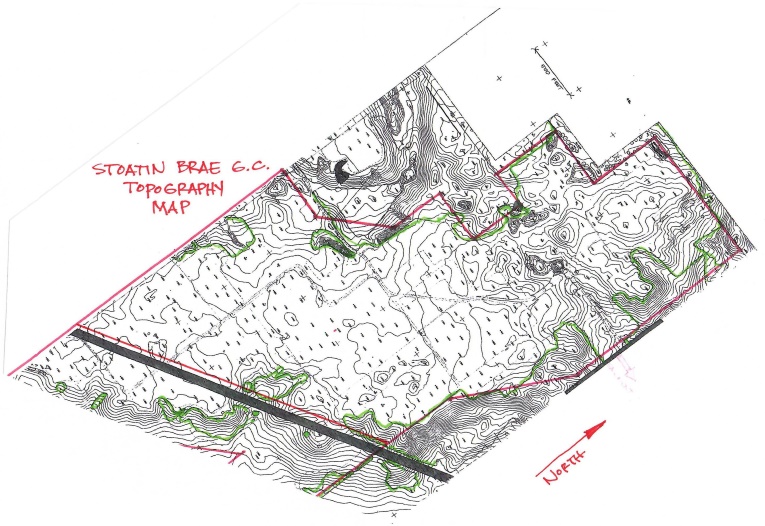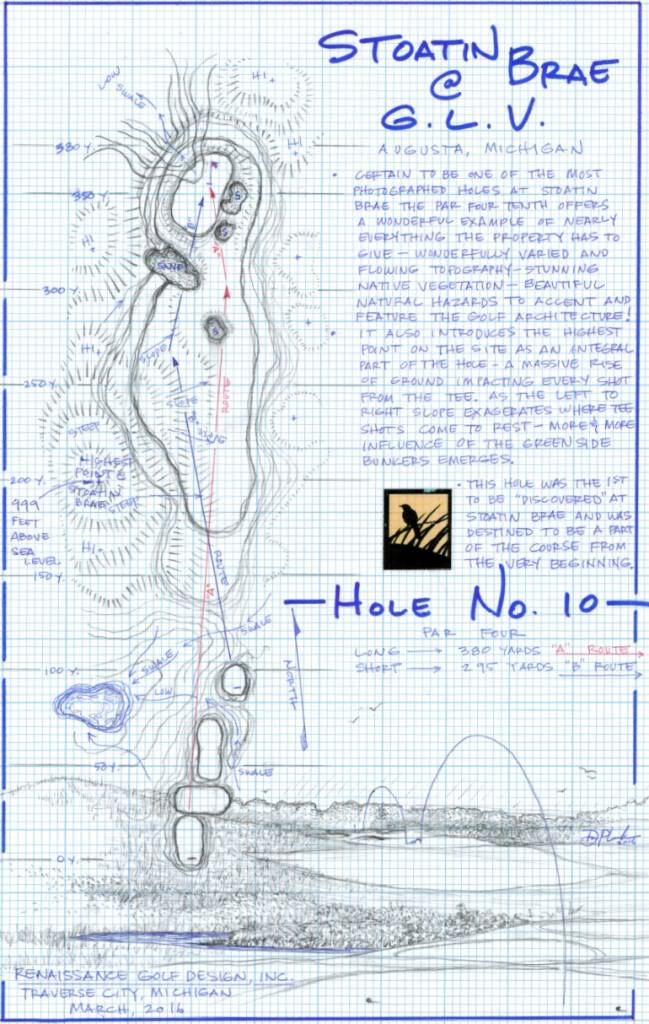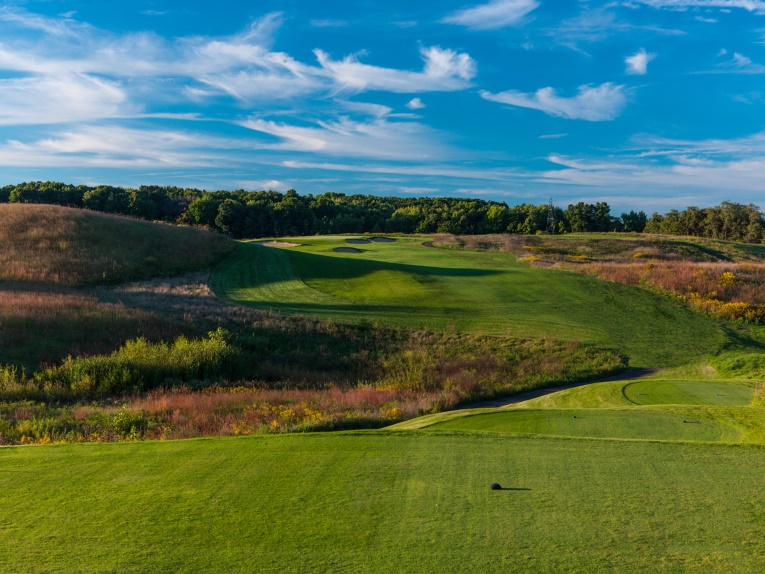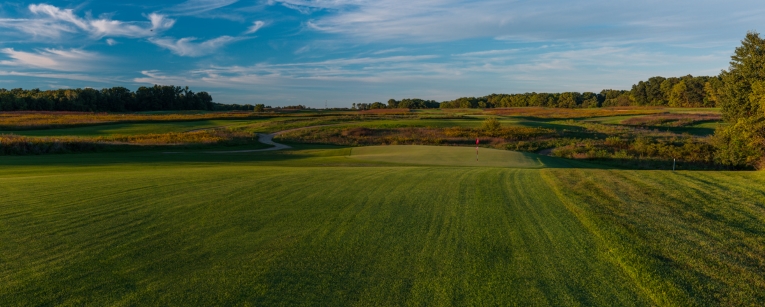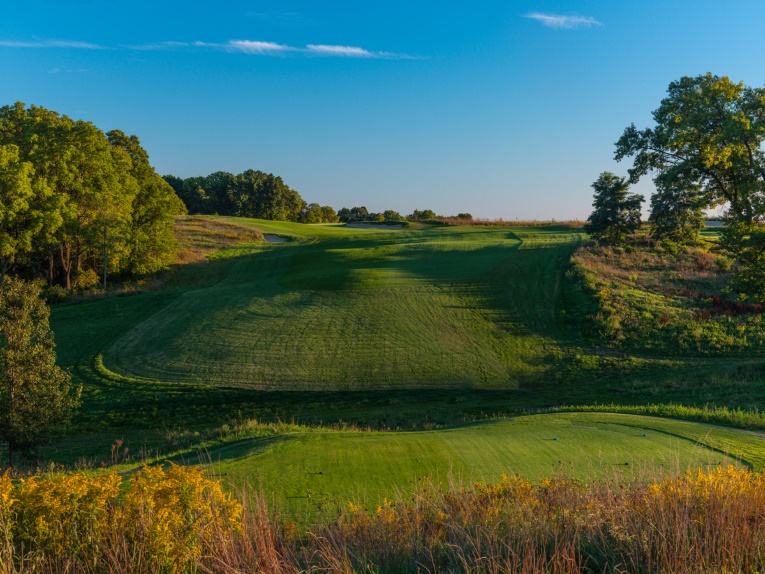Feature Interview with Eric Iverson, Don Placek, Brian Schneider, and Brian Slawnik
July, 2017
The following is an Exit Interview conducted by Tom Doak with the four designers of Stoatin Brae, which opened for play in May, 2017.
So, how do you collaborate on a design? Doesn’t somebody have to make the final decisions?
Don Placek: It was easy at the beginning because everyone was enamored by the idea. It was a great opportunity on an interesting piece of land. Everyone has their fortes, and what they’re good at finding, and building, and noticing. But as we got further into the process, there was a healthy competition for figuring out the best set of holes.
Brian Slawnik: We’re used to collaborating with Tom and with each other building holes in the field. Typically, Tom has the final say; in this case, it was the guys building the holes, but not without some comment from the rest of the group.
Eric Iverson: Yes, eventually someone has to make a decision. Once we started building, a lot of that fell on Brian Schneider and myself, simply because we were there more often. Even then, we conferred and ultimately agreed on the final product.
Did owner Jon Scott have clear, stated goals for what he wanted?
DP: The whole scheme of the place was about building a course that we would like and would meet his needs, too, with regard to pace of play and the maintenance budget. That’s how we wound up with bluegrass fairways: we thought having width was important to keeping the course fun to play, but it didn’t make sense to maintain that much bentgrass if they wanted to keep to their cost structure.
EI: The site was different than what the Scott family had built on before: their other courses are more wooded, and this was an orchard site on top of a hill, that had been cleared of trees. It was different enough to be appealing to Jon, and maybe to scare him a little, too; I’m not sure he could quite visualize what was going to make it look good in the beginning, but he had faith in us to sort that out. Absent trees on the interior, some people would have said it was just barren property, but we saw a lot more in it than that.
Was there anything in particular you tried to do to make it different than one of my (i.e. Tom’s) courses?
Brian Schneider: The fact that it wasn’t a sandy site meant it would look different than most of the courses we’ve built for Tom lately. That meant fewer bunkers, for starters. There were times as I was building things where I did try to think how Tom would edit what I’d done.
Slawnik: We always try to make a new course look different than what we’ve built before, even for Tom. There’s a lot of time in the early going trying to feel out what the ground wants to be. It’s a big-scale property with long elegant lines, and not a lot of rumply jazz.
Did you have any personal goals?
DP: I just know how much talent there is among the other three guys, and I was excited to see them get a free swing at it. We all knew it was a great chance to demonstrate that we’re an excellent, affordable option for the right project.
How did you approach the routing process?
DP: Everybody took a crack at the routing independently, because we all know how hard it is to get a hole out of your mind once you’ve seen someone else’s plan. The property is long from north to south, and pretty narrow, so we knew there would be some similarities between the plans.
Slawnik: Everyone was fired up about #10, because we all had some version of that hole in our plans. My routing was kind of backwards from everyone else’s; to get to the back corner, I had a long par-4 over some difficult ground, that eventually became #12. I’m glad that worked out, because I had my finishing holes going along the west side of the site, and I got outvoted on most of those!
EI: Having confidence that we could make #12 work unlocked the rest of it; we knew there would be some cool par-3 holes back in the corner of the property, but #12 allowed us one more two-shot hole that helped get a bit more out of it. We had to cut a ridge down about 12 feet at the landing area to make it work. That’s one thing we’ve learned from Tom; sometimes making one big change lets everything else stay more natural.
EI: Having confidence that we could make #12 work unlocked the rest of it; we knew there would be some cool par-3 holes back in the corner of the property, but #12 was sort of a bonus long hole that helped get a bit more out of it. We had to cut a ridge down about 12 feet at the start of the fairway to make it work. That’s one thing we’ve learned from Tom; sometimes making one big change lets everything else stay more natural.
Was the clubhouse site a given?
DP: The access road had to come up right there, and it’s a beautiful view for the restaurant, which was important to Jon. Going back further into the property would have meant building more road and trying to hide it. Jon understood that would make it difficult to have returning nines, but for Gull Lake View, Stoatin Brae is more of a “destination” course, they didn’t think many of their customers would drive over just to play nine anyway.
Which holes were your favorites at the start of the construction, and are those still your favorites?
Slawnik: In addition to #12, I really liked the setting for #2, which has its own little view. But going back, I had a similar reaction to my feelings about Pacific Dunes, that some of the most interesting golf is in the flatter midsection of the property. When you make something out of nothing and it works, that’s a little more rewarding. The short par-4 #8 is a great example; I guess that’s one of the last holes they finished, because it took Jon Scott a while to get comfortable with the green.
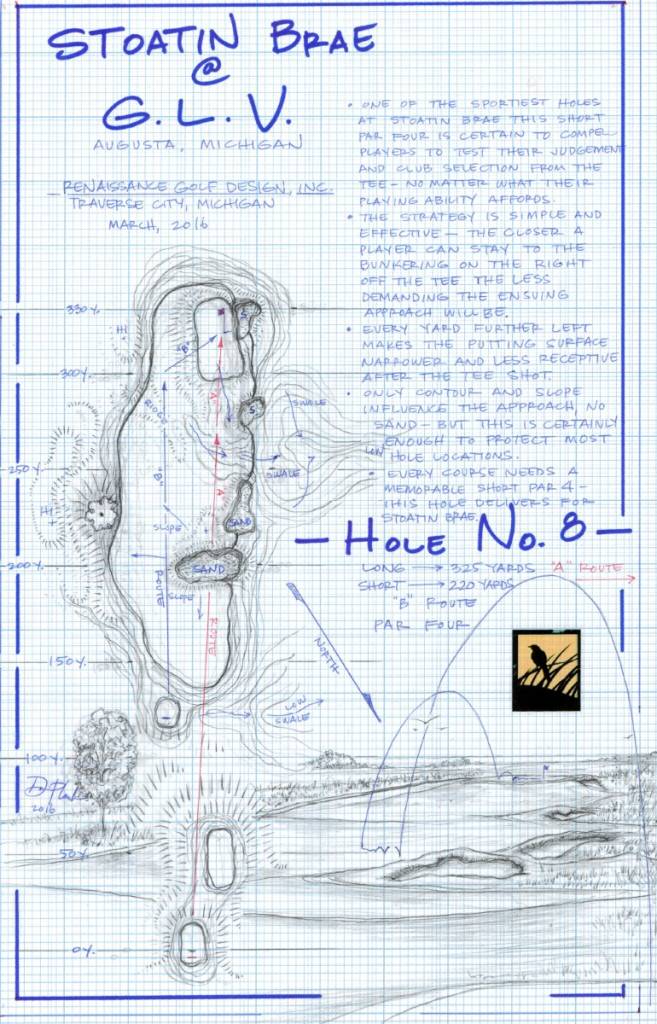
The golfer has to flirt with the trouble down the right in order to enjoy a pitch along the green’s axis.
Schneider: I was drawn to the holes in back at the start of the project; #15 is an interesting combination of a pretty dramatic tee shot and a cool, subtle green site. But, I agree with Brian that the holes in the middle turned out way better than I imagined. #5 has a tee shot that sets up for a draw, and then a fade on the approach.
EI: I was especially fond of the wooded corner where #7 green sits, and I also liked the 18th, which plays toward a big V in the tree line in the distance. The holes that flipped for me are #4; the green has a cool little cutout that shows up on the horizon, and #8. That one kept getting pushed back in the order, with nothing obvious to work with. It fell to Brian, and he came up with a fantastic, vexing little par 4.
DP: I’m a little surprised no one mentioned the two par three’s on far North end, 11 and 14, I always thought they would be sporty one-shot holes that are “easy on the eyes.” Perhaps because they are complimented with interesting native surroundings and flanked by some great bunker work. Blake Conant was such an asset on the project but it may be his work with the bunkers and developing their understated style that was one of his biggest contributions. I guess maybe these holes don’t come to mind as quickly because we are always thinking about strategy and one-shot holes inherently require a little less of that than 4’s and 5’s do. The 16th is a beautiful hole with its green resting so comfortably on the horizon looking over the Kalamazoo River Valley below. I don’t know if that ended up being Eric’s green or Schneider’s; they are both so good at that.
Many of the greens are at grade; what grasses did you go with and why?
DP: The specifics of the grasses, as prescribed by Tom Mead, are Bedazzled, Bewitched and Jumpstart Kentucky Bluegrasses – 30%, 30% and 20% respectively. 20% of the rough is Intrigue Chewings Fescue. Essentially a three way blend of “Low Mow” Bluegrass with a fescue nurse plant component.
EI: About the grass, we convinced Jon that he could get a really good playing surface out of these newer bluegrass types. The trade off was that we felt the fairways needed to be really wide, and it was hard to justify the expense of bent. The bluegrass also allowed us to minimize cart paths. The soils are not sandy, and any attempt at fescue would have required limiting cart traffic. While the course is built to be walked, the whole point of it was to welcome all comers.
And so from a maintenance perspective …
EI: Very easy to maintain, limited bunkers, no trees, limited separate mowing heights.
Question to Eric: You’re the only one of the four who had designed a course on your own, before you started working for Renaissance Golf. How did that experience help?
EI: It was a huge help. We’ve all been at it a long time now, but when I did my first course on my own, my errors were all on the side of severity. That gave me a better perspective on finding the right balance between trying too hard to leave a mark, vs. being too conservative for fear of offending someone, particularly our client. Jon made clear early on that he liked contour, so we felt very free in that regard. There’s a good mix of greens: some really good subtle ones, and a couple that are pretty edgy.
What was the hardest part of the process?
Slawnik: For me, it was that I was so busy building The Loop that I couldn’t get down there a lot to help!
Schneider: Jon and his team were accustomed to a certain approach to construction, as are we, so it took a while for everyone involved to get on the same page. It was important to us to preserve the natural small-scale features of the site and to get details like horizons, clearing and mowing lines just right – since “just right” can mean different things to different people, some of those decisions required a bit more back-and-forth than we’re used to. And getting comfortable with having the final say on a green was hard for me; when we work with Tom, we can push the envelope a bit more, knowing Tom will dial it back for us if that’s what it needs.
EI: We had to win the confidence of the client, and convince him to let us build some holes that are unconventional. With Tom, most clients are already on board with all of that, so we don’t have to worry about it much. Our agreement at the beginning was that we were building the course WITH Jon, not FOR him.
DP: I think it helped that Jon’s dad, Charlie, is more conservative about golf than Jon is, so Jon could relate a little bit to us wanting to push boundaries.
What do you think golfers will enjoy most about Stoatin Brae?
DP: Because it isn’t readily apparent, one aspect of the course I hope golfers enjoy about Stoatin Brae likely won’t come until after their round. And that’s the fact the opening and closing stretches of holes, for the most part, reside on the more elegant and understated contours of the property with the middle section of the course, especially holes10-15, hosting the the more dramatically heaving and tilting landforms. Its one of the things driven by the clubhouse location that really worked itself out nicely. Some might say there should have been more effort to “jazz up” the quieter ground with fairway bunkers and added fairway wrinkles, but often the contrast in the holes can be a real asset in helping players appreciate a course that has some of everything! At Stoatin we aspired to give golfers as much flavor as possible without too much of any one ingredient. And property had that in store from the very beginning, a lovely cadence of contour.
Schneider: I think it’s a unique setting for that part of Michigan, the long views are more like something you’d find up north. Visually, it’s not too busy, but there are enough features to make you think if you get off line.
EI: It suits my vision of an ideal course: it can be played by a foursome that including a scratch golfer to 36-handicapper, and they’ll all be able to enjoy it on their own terms. We did our best to make it wide enough that you can find your ball and have a good time, but really good players will be challenged to find the right spots to attack the orientation of the greens. It’s also a really nice walk; the greens and tees are close together and there’s not a lot of wasted space.
Slawnik: It’s a real contrast with the other courses at Gull Lake View. Hopefully their clientele like how open and expansive it feels, although I don’t think they’ll find it any easier to score on. It’s an unexpectedly pretty site, and a nice place to spend the day, even if you’re just there to tag along and watch.


